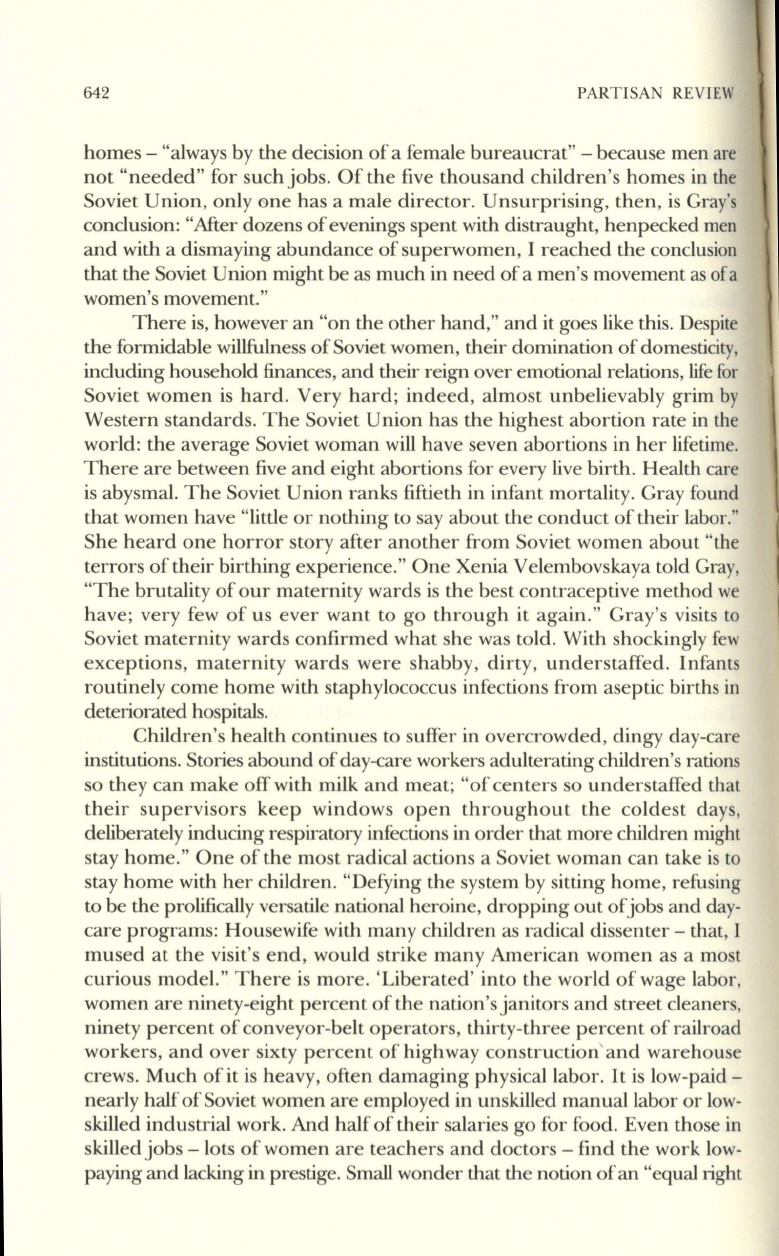
642
PARTISAN REVIEW
homes - "always by the decision of a female bureaucrat" - because men are
not "needed" for such jobs. Of the five thousand children's homes in the
Soviet Union, only one has a male director. Unsurprising, then, is Gray's
conclusion: "After dozens of evenings spent with distraught, henpecked men
and with a dismaying abundance of superwomen, I reached the conclusion
that the Soviet Union might be as much in need ofa men's movement as ofa
women's movement."
There is, however an "on the other hand," and it goes like this. Despite
the formidable willfulness ofSoviet women, their domination of domesticity,
including household finances, and their reign over emotional relations, life for
Soviet women is hard. Very hard; indeed, almost unbelievably grim by
Western standards. The Soviet Union has the highest abortion rate in the
world: the average Soviet woman will have seven abortions in her lifetime.
There are between five and eight abortions for every live birth. Health care
is abysmal. The Soviet Union ranks fiftieth in infant mortality. Gray found
that women have "little or nothing to say about the conduct of their labor."
She heard one horror story after another from Soviet women about "the
terrors of their birthing experience." One Xenia Velembovskaya told Gray,
"The brutality of our maternity wards is the best contraceptive method we
have; very few of us ever want to go through it again." Gray's visits to
Soviet maternity wards confirmed what she was told. With shockingly few
exceptions, maternity wards were shabby, dirty , understaffed. Infants
routinely come home with staphylococcus infections from aseptic births in
deteriorated hospitals.
Children's health continues to suffer in overcrowded, dingy day-care
institutions. Stories abound of day-care workers adulterating children's rations
so they can make off with milk and meat; "of centers so understaffed that
their supervisors keep windows open throughout the coldest days,
deliberately inducing respiratory infections in order that more children might
stay home." One of the most radical actions a Soviet woman can take is to
stay home with her children. "Defying the system by sitting home, refusing
to be the prolifically versatile national heroine, dropping out ofjobs and day–
care programs: Housewife with many children as radical dissenter - that, I
mused at the visit's end, would strike many American women as a most
curious model." There is more. 'Liberated' into the world of wage labor,
women are ninety-eight percent of the nation's janitors and street cleaners,
ninety percent of conveyor-belt operators, thirty-three percent of railroad
workers, and over sixty percent of highway construction' and warehouse
crews. Much of it is heavy, often damaging physical labor.
It
is low-paid–
nearly half of Soviet women are employed in unskilled manual labor or low–
skilled industrial work. And half of their salaries go for food. Even those in
skilled jobs - lots of women are teachers and doctors - find the work low–
paying and lacking in prestige. Small wonder that the notion ofan "equal right


